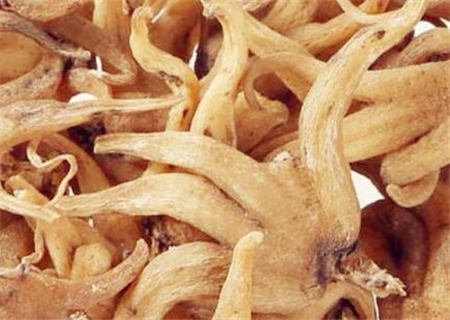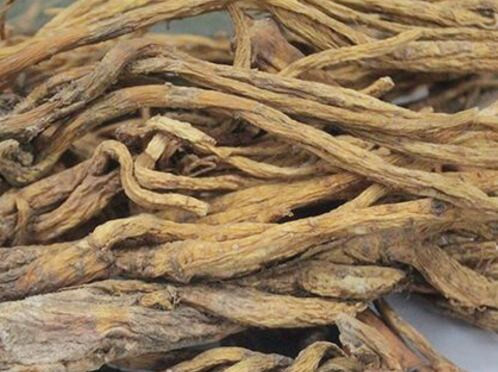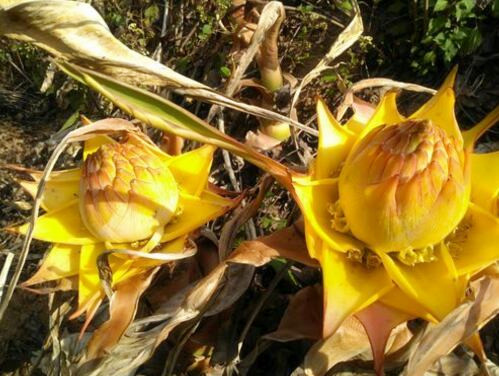Wild bergamot ginseng (palm ginseng) how much is it per gram? What is the main place of origin? When is the best time to harvest? (with planting
Bergamot ginseng, also known as palm ginseng, is a kind of plant, named because it looks like the palm of the hand, and is mainly used in medicine. So how much is the palm ginseng per gram? What is the main place of origin? When is the best time to harvest?

Wild bergamot ginseng (palm ginseng) how much is it per gram? Palm ginseng is a wild resource, as the supply of goods available in the market has not been abundant, the price of unified goods in Sichuan is stable between 500 and 550 yuan.
Distribution of producing area
Born in alpine meadows or moist and fertile places on the edge of forests. Distribute Xizang and other places.
Cultivation techniques
Land selection and land preparation
Palm ginseng has strict requirements on soil, and ph4.5-5.8is rich in humus. It is better to avoid continuous cropping on sandy soil or soil with convenient drainage and irrigation. Generally use woodland to plant ginseng. If the ginseng is planted in farmland, it is better to use Gramineae crops in the previous crop, and it can only be planted for a year after harvest. After selecting the land, plough it twice before freezing, with a depth of 20 cm. The following spring freezing combined with ploughing, 4000 kg of farm manure was applied per mu, mixed well with the soil, and then ploughed once every 1-2 months. About a month before planting, break the clods, remove debris, prepare the land, the border is l-l.5 meters wide, slightly arched, the border height is 25-30 cm, and the width of the operating road between the borders is 50-100cm. Only the direction varies according to topography, glass direction, shed type, etc., and should be based on the principles of reasonable daylighting, high land utilization rate, favorable drought prevention and drainage and convenient field operation.
The planting ginseng in the flat land is mostly planted in the south, while the ginseng planted in the mountain area should be planted in Hengshan and Shunshan or at a certain angle according to the slope of the mountain.
Reproduction method
The main results are as follows: (1) during the period from July to August, the seeds can be sown while the seeds are fresh, the seeds go through the post-ripening process in the soil, and the seedlings can emerge in the next spring. Or burying the seeds in sand to accelerate germination. The method is to choose a sunny and dry place and dig a pit 15-20 cm deep. Its length and width depend on the number of seeds. The bottom of the pit is covered with a layer of pebbles and the top is covered with a layer of sifted fine sand. Rub the fresh ginseng seeds to remove the peel, or soak the ginseng seeds in clean water for 2 hours, mix them with the same volume of wet fine sand, put them in the pit, cover fine sand 5-6 cm, and then cover them with a layer of soil, which is covered with a layer of weeds to keep them moist and strictly covered on rainy days to prevent Rain Water from flowing into rotten seeds. Check and turn once every half a month, if there is not enough water, spray water appropriately; if the humidity is too high, screen out ginseng seeds and dry sand. After natural temperature change, the seed can complete the post-ripening process of embryo, and winter sowing can be carried out in the first and middle of November. It can also be sowed in spring, when the seeds have not yet germinated before and after the Spring Equinox. The sowing method is to sow on the whole border surface according to row spacing of 5 cm, plant spacing of 3 cm, cover soil of 2 cm, and then cover straw 3-5 cm thick for moisturizing. For the cracked seeds treated by sand storage, if the seeds were soaked with 0.1ml / L ① abt rooting powder solution, the root weight could be significantly increased.
(2) transplanting seedlings after 2-3 years, usually from the end of October to the first ten days of November. Such as spring planting should be carried out when the ginseng seedlings have not yet germinated. Strong seedlings with milky white roots, no diseases and insect pests, hypertrophy of spores, enough pulp and long roots were selected for transplanting according to the three grades of large, medium and small. Before planting, you can properly reshape the fibrous root, remove the excess fibrous root, be careful not to tear the root bark, and soak the root with 100,200x solution of Dysen zinc or 140x Bordeaux solution of 1 ∶ 1 ∶ for 10 minutes, be careful not to soak the spores. When transplanting, form a horizontal row with a row spacing of 25-30 cm and a plant spacing of 8-13 cm. Flat or oblique planting. The flat ginseng root is parallel to the border base; the oblique planting is head up, and the ginseng root is at an angle of 30-45 degrees with the border base. Oblique planting ginseng roots cover soil deeply, which is beneficial to drought prevention. After opening the ditch, put the ginseng root in place, first use the soil to cover all the ginseng root, and then flatten the border surface. The depth of soil cover depends on the size of the seedlings, usually 4-6 cm, and then cover the border with straw to preserve soil moisture.
Field management
(1) Winter management
From late October to early November, when the stems and leaves of Ginseng which have been growing for more than one year wither, the withered leaves should be removed from the ground in time, buried or burned. Look at the condition of the border before freezing, boil the overwintering water, and cover the straw.
(2) setting up a shed for shade
After the ginseng seedlings are unearthed, they should set up a shed in time for shade. There are two kinds of greenhouse: low shed and high shed. The height of the eaves column in front of the low shed is 90-120 cm, and that of the back eave column is 70-90 cm. Wooden and cement columns are available to separate the sides of the ginseng border. The crossbar is fixed along the border on the pillar, and the crossbar is often made of bamboo, or tightened iron wire can be used. It was covered with a Reed curtain 1.8-1.2m wide, so that Rain Water could not fall directly on the border. Cover the second Reed curtain before the rainy season. The canopy should be flat and straight to prevent uneven. The high shed covers the entire ginseng land, with a height of 1.8-1.2 meters, with cement poles as columns and bamboo poles as crisscross scaffolding, which is covered with Reed curtains and has a light transmittance of 25% and 30%.
(3) weeding and loosening the soil
Before the emergence of palm ginseng, or when the soil is hardened, the soil moisture is too high, and there are many weeds on the border, weeding and loosening should be carried out in time in order to keep the soil loose and reduce the damage of weeds, but the times should not be too much.
(4) after drainage and irrigation sowing or transplanting, in case of drought, timely sprinkler irrigation or infiltration irrigation. If there are too many Rain Water, he should dig a good drainage ditch and discharge the stagnant water in time.
(5) topdressing
In the year of sowing or transplanting, there is generally no topdressing. Before the spring seedlings are unearthed in the next year, remove the straw covering the border, sprinkle a layer of rotten farm manure, apply a small amount of superphosphate, loosen the soil, mix it well with the soil, and water the soil immediately when the soil is dry. During the growing period, 2% calcium superphosphate solution or 1% potassium dihydrogen phosphate solution can be used to top fertilizer outside the root.
(6) cultivating soil and developing buds
Because the covering soil is too shallow or shaken by the wind, when the ginseng root is loose, the soil should be cultivated in time. For the ginseng plants near the front of the ginseng border or the edge of the ginseng field, because of the phototaxis, the stems and leaves grow outward, and the high temperature and rain in summer can easily cause many diseases such as spot disease and blight, so the ginseng plants growing outward should be pushed into the border and compacted with soil to make them grow inward. After 3 years of growth, ginseng can blossom and bear seeds every year, and the buds should be removed in time for the plots that do not harvest seeds.
Harvesting and processing
The palm ginseng can be harvested when the stems and leaves wither from September to October after 5-6 years of transplanting for 4 years. When harvesting, first dismantle the shed, starting from one end of the border, dig out the ginseng roots line by line with two-toothed picks, shake off the soil, clean the stems and leaves, and grade them according to size. Wash the ginseng root, cut off the fibrous root and lateral root, sun-dry or dry, that is, raw sun ginseng. Choose a well-shaped, full-bodied, intact ginseng root and rinse it in clean water, scrape off the dirt on the scar, pinch off the fibrous root and adventitious root, steam for 4 hours after boiling water, take out and dry in a drying room of 60 ℃, and get red ginseng.
Time: 2019-03-19 Click:
- Prev

How much does gentian branch gentian seed price a catty? How to grow? What are the effects and functions?
Gentiana macrophylla, alias: Gentiana macrophylla, Gentiana macrophylla, Gentiana macrophylla. Produced in Mongolia, Russia, the mainland of China of Inner Mongolia, Ningxia, Hebei, Shaanxi, **, Northeast, Shanxi and other places. Has extremely high medicinal value. So, how much is the price of Gentiana seed? How to grow? What are the effects and functions? it is understood
- Next

How to raise the earth surge golden lotus? How many years to plant? Can I eat it? What are the effects and functions?
The earth surging golden lotus is also known as thousand-petal lotus flower, earth golden lotus flower, indestructible golden steel, etc. Yunnan origin of China, for China's specialty flowers. It is regarded as one of the five trees and six flowers by Buddhist temples. So, how do you raise the Earth Surging Golden Lotus? How many years to plant? Can I eat it? What are the effects and functions? How to raise the ground
Related
- Fuxing push coffee new agricultural production and marketing class: lack of small-scale processing plants
- Jujube rice field leisure farm deep ploughing Yilan for five years to create a space for organic food and play
- Nongyu Farm-A trial of organic papaya for brave women with advanced technology
- Four points for attention in the prevention and control of diseases and insect pests of edible fungi
- How to add nutrient solution to Edible Fungi
- Is there any good way to control edible fungus mites?
- Open Inoculation Technology of Edible Fungi
- Is there any clever way to use fertilizer for edible fungus in winter?
- What agents are used to kill the pathogens of edible fungi in the mushroom shed?
- Rapid drying of Edible Fungi

